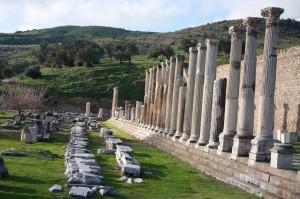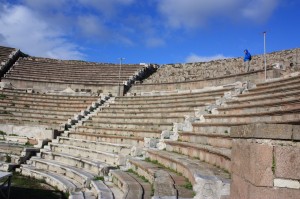After the day’s visit to Troy, we went on to Pergamon, now know as Bergama. We stayed in an old, stone, Greek house that has been restored for guests. Very cozy and quaint, it was also very drafty. In Turkey, being cold and drafty only matters for about two months of the year, and that is the time we visited. It did help us become closer, though; literally, as we had to huddle together to stay warm.
Our first day there led us to a visit of the Asklepion, the ancient world equivalent to today’s hospital, or more accurately, an alternative medicine equivalent. The Asklepion is named for the Greek god, Asklepius, who had daughters that included Panacea and Hygieia. With names like that, they must have been great helpers in healing people. Many of the techniques that were employed there are familiar today; massage, music, mud baths, dream analysis, the sound of flowing water, and herbal remedies. They even had their own music hall, a 3,500 seat amphitheater. I don’t know if they had much success, but it must have been a great place to visit! No word, though, whether it was private pay, or a government-run program. To help improve their success rate, they employed a triage system to decide who could be a patient. If the examiner determined you were going to die, or if you were pregnant, you were not eligible for care. Patients who did get treated there included the Roman emperors Hadrian, Marcus Aurelius, and Caracalla. (No HIPAA regulations then regarding releasing patient names and information.) Like the Mayo Clinic, the Asklepion had it’s own famous physician to help attract patients. Apart from Hippoctrates, Galen was the most famous physician in the ancient world, and medical students continued to study his works well into the 19th century. Born in Pergamon, he did his training there, went off to become the emperor’s physician, and then returned to be become the gladiator’s physician. Good trauma care was important.
The amphitheater and the round, domed patient care building, called the Temple to Asklepius and modeled after the Pantheon, built only 20 years before, were the only two buildings from which much remained. The temple building was reached via an underground tunnel, through which water was diverted to trickle down under the sides of the stairs, and which continues to this day. It provides a wonderfully soothing atmosphere. Reinforcing the idea that there is nothing new under the sun, today’s hospitals are being built with this in mind.
-Mitch
1/10/11


Mitch … we love to read about your families adventures; I am forwarding this on to our son John who lives in Soul Korea ( he teaches english ) he often travels to thialand I think he will be there over Christmas. Let me know if your headed to Soul
Take care …. Hugs